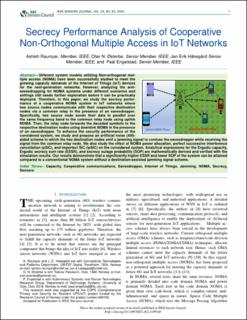| dc.contributor.author | Rauniyar, Ashish | |
| dc.contributor.author | Østerbø, Olav Norvald | |
| dc.contributor.author | Håkegård, Jan Erik | |
| dc.contributor.author | Engelstad, Paal | |
| dc.date.accessioned | 2022-10-14T12:53:45Z | |
| dc.date.available | 2022-10-14T12:53:45Z | |
| dc.date.created | 2022-08-26T10:55:05Z | |
| dc.date.issued | 2022 | |
| dc.identifier.citation | IEEE Sensors Journal. 2022, 22 (19), 19030 - 19045. | en_US |
| dc.identifier.issn | 1530-437X | |
| dc.identifier.uri | https://hdl.handle.net/11250/3026184 | |
| dc.description.abstract | Different system models utilizing Non-orthogonal multiple access (NOMA) have been successfully studied to meet the growing capacity demands of the Internet of Things (IoT) devices for the next-generation networks. However, analyzing the anti-eavesdropping for NOMA systems under different scenarios and settings still needs further exploration before it can be practically deployed. Therefore, in this paper, we study the secrecy performance of a cooperative NOMA system in IoT networks where two source nodes communicate with their respective destination nodes via a common relay in the presence of an eavesdropper. Specifically, two source node sends their data in parallel over the same frequency band to the common relay node using uplink NOMA. Then, the relay node forwards the decoded symbols to the respective destination nodes using downlink NOMA in the presence of an eavesdropper. To enhance the security performance of the considered system, we study and propose an artificial noise (AN)-aided scheme in which the two destination nodes emit a jamming signal to confuse the eavesdropper while receiving the signal from the common relay node. We also study the effect of NOMA power allocation, perfect successive interference cancellation (pSIC), and imperfect SIC (ipSIC) on the considered system. Analytical expressions for the Ergodic capacity, Ergodic secrecy sum rate (ESSR), and secrecy outage probability (SOP) are mathematically derived and verified with the simulation results. Our results demonstrate that a significantly higher ESSR and lower SOP of the system can be attained compared to a conventional NOMA system without a destination-assisted jamming signal scheme. | en_US |
| dc.language.iso | eng | en_US |
| dc.publisher | IEEE | en_US |
| dc.subject | Sensorer | en_US |
| dc.subject | Sensors | en_US |
| dc.subject | Kommunikasjon og distribuerte systemer | en_US |
| dc.subject | Communication and Distributed Systems | en_US |
| dc.subject | Internet of Things | en_US |
| dc.subject | Internet of Things | en_US |
| dc.subject | Kommunikasjonssikring | en_US |
| dc.subject | Communication Security | en_US |
| dc.subject | Kapasiteten til forbindelser | en_US |
| dc.subject | Connection capacity | en_US |
| dc.title | Secrecy Performance Analysis of Cooperative Nonorthogonal Multiple Access in IoT Networks | en_US |
| dc.type | Peer reviewed | en_US |
| dc.type | Journal article | en_US |
| dc.description.version | acceptedVersion | en_US |
| dc.subject.nsi | VDP::Sikkerhet og sårbarhet: 424 | en_US |
| dc.subject.nsi | VDP::Security and vulnerability: 424 | en_US |
| dc.subject.nsi | VDP::Sikkerhet og sårbarhet: 424 | en_US |
| dc.subject.nsi | VDP::Security and vulnerability: 424 | en_US |
| dc.source.pagenumber | 19030 - 19045 | en_US |
| dc.source.volume | 22 | en_US |
| dc.source.journal | IEEE Sensors Journal | en_US |
| dc.source.issue | 19 | en_US |
| dc.identifier.doi | 10.1109/JSEN.2022.3199540 | |
| dc.identifier.cristin | 2046253 | |
| dc.relation.project | Norges forskningsråd: 300102 | en_US |
| cristin.ispublished | true | |
| cristin.fulltext | postprint | |
| cristin.qualitycode | 2 | |
